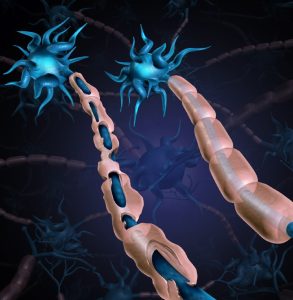Repair of MS damage and the potential for the reversal of the effects of MS are always on the minds of doctors, researchers and those living with the disease.
Despite great progress in treating MS in recent years, paths to true MS repair have remained elusive. Before getting into one potential avenue for repair that’s gained some attention with researchers recently, let’s review some basic MS science.

This illustration depicts a normal, healthy nerve on the right, compared to a nerve with damaged myelin on the left. MS causes an autoimmune response that damages the nerve’s protective myelin coating, which impacts the nerve’s ability to effectively process electrical impulses. “Remyelination” refers to the possibility of repairing and regenerating areas where myelin has been damaged.
The central nervous system (CNS) is made up of the spine and brain. Nerve fibers in the CNS communicate with each other and many other organs via long cables called axons. The large axons of the CNS are wrapped in a substance called myelin, a sheath of fat and protein, which protects the axon and helps the nerves conduct electrical impulses to and from the brain and spine.
MS may cause injury in multiple locations in the CNS and the optic nerve. While the exact cause remains unknown, it appears the primary problem in MS is that the immune system mistakenly attacks this myelin coating around axons.
Understanding that this damage to the myelin sheath is the primary event in MS disease activity, it’s natural to look at protecting and repairing myelin as a way to combat, stop, or even reverse the course of MS.
Repairing and regenerating myelin is usually described as “remyelination,” and has been the subject of much research. We do know that the body has some capacity to spontaneously regenerate myelin on its own — in fact, early researchers working with the brains of MS patients observed the phenomenon as far back as the early 1900s.
However, how and when this remyelination occurs on its own is unpredictable.
The question that remains is whether or not modern therapies or treatment techniques can either spark this spontaneous remyelination process, or generate remyelination on their own. Evidence for this has, unfortunately, come up rather short.
Several studies have shown only modest impacts in this area. And studies around one notable potential molecule – opicinumab, also known as anti-LINGO-1 – have been abandoned after negative results in early trials.
However, one promising development is metformin, which is a drug available under a number of brand names and is currently used to treat Type 2 Diabetes. In MS animal models, metformin has shown neuroprotective properties and also may aid in remyelination. Metformin is an anti-oxidant and reduces metabolism in cells.
Although studies are ongoing, there is potential for metformin to be used as an add-on treatment for patients who are on anti-CD20 DMTs (ocrelizumab, ofatumumab, rituximab), which are known to inhibit remyelination.
For remyelination to be effective, it will need to be done before the axons are significantly damaged and thus disappear (one of the causes of brain atrophy). And it should be noted that remyelination would repair the protective myelin coating, but not repair damaged nerves themselves.
Whether remyelination therapies can be effective requires more study and research, which is ongoing at the Rocky Mountain MS Center and elsewhere. And there are still questions as to whether remyelination – if successful – can or will lead to significant repair or reversal of the effects of MS, or have an impact on a patient’s accumulated MS disability.

